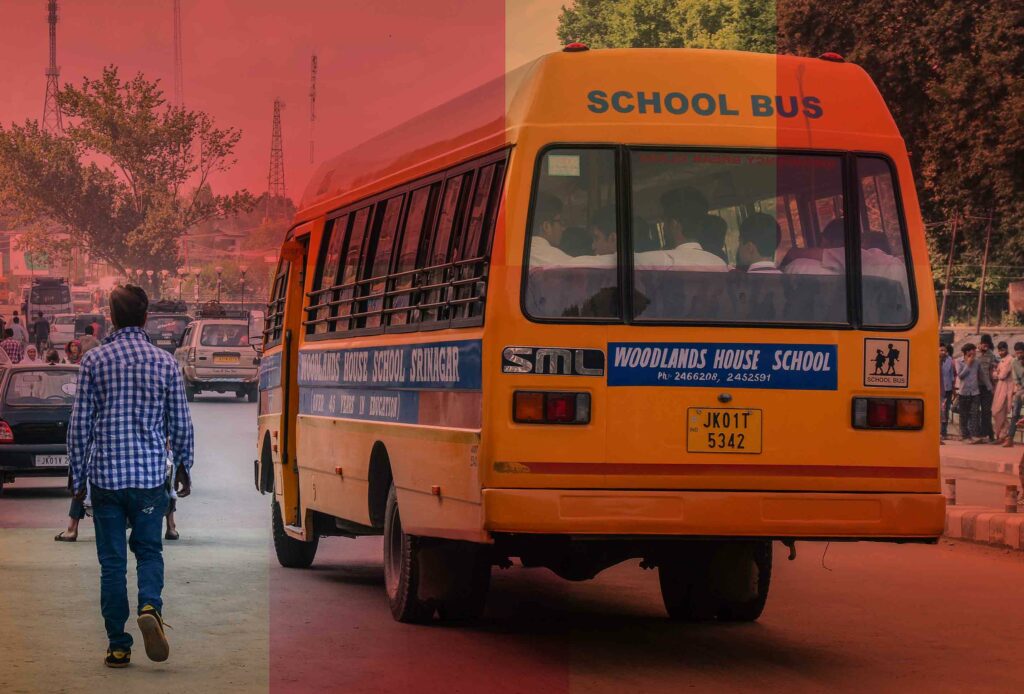From China to Pune to Pulwama, edtech is bringing down learning hurdles even in tough conditions
Through jugaad and passion, Indian innovators are solving critical problems for underprivileged communities
As the internet democratises learning, edtech is going beyond fancy tablets and digital classrooms and to the streets
India's Edtech Moment
Technology is upending the traditional ways of teaching and learning. What does the future of education hold?
As the saying goes, not all heroes wear capes.
Ordinary everyday stories are often just as inspiring as multibillion-dollar action movies wrapped up a tribute to those who make a difference. Even when it comes to edtech, there are heroes who move among us, shying away from the limelight as much as possible, while quietly changing the world in their own ways. While the stories of most such heroes go unheard and unnoticed, we wanted to shine a light on these humans that are making the best use of whatever technology is available to them to spread the joy of learning and teaching.
Any look at the edtech sector would be incomplete without tipping our hats to these humans of edtech.
Yes, it’s a break from the rise of edtech startups or from the existential questions of what technology means in the context of education, and whether edtech is indeed as revolutionary as it claims. These amazing stories come from around the world, as learning truly has no barrier in today’s day and age.
Year Of The Rat

For more than a month, the novel coronavirus has gripped the medical world and the public at large. It is said to have originated in Wuhan, the capital city of China’s Hubei province. And while the disease has now been named Covid-19, a cure or vaccine is far from ready. As of February 22, 2020, there have been over 77K confirmed cases in the world, and over 2,239 deaths in China alone, Covid-19 as proven to be deadlier than expected. Outside China, there are 1,200 cases in 26 countries, and eight deaths, according to WHO.
The streets, public spaces and markets wore a deserted look ahead of the Chinese New Year in many major cities in China as most celebrations got cancelled. People anxious to avoid the spreading virus stayed indoors — a complete breakaway from the pounding drums and firecrackers that are common at this time of the year. Wuhan was unsurprisingly the worst hit.
As the old and very young are the ones most affected by the coronavirus, schools have also shut down across most of mainland China. As of January 27, China’s government authorities also cancelled all February IELTS, and the TOEFL exams, which is likely to disrupt the plans of Chinese students who make up the sizeable international student population in the US — 34% of all foreign students in the US in 2019 were from China according to the Institute Of International Education.
Whereas Covid-19 might yet have a long term impact on the student market in the US. With no quick cure in sight, edtech came to the rescue of primary and secondary schools which are now turning to online classes to continue with the semester.
China’s “National Cloud Classroom,” which was developed in the 2000s has sprung into action.
China-based YouTube video site Youku started offering classes for primary and secondary school students because of the suspension of schools due to the coronavirus epidemic. Similarly, other online education companies are also going with free classes. This includes the New Oriental Group, China’s largest private education company as well as VIPKid, one of the few English learning-focussed platforms in the mainland.
The Vision Of Edtech
Beyond China, where everything is tightly controlled by the regime, technology has opened up newer ways of teaching and learning in other places where the curriculum is more flexible, or in some cases simply non-existent.
![Visually-impaired students learn to type without a monitor, thanks to smartphones [Image Credit: Swalekhan]](https://inc42.com/wp-content/uploads/2020/02/shutterstock_-scaled.jpg)
As computers and tablets become ubiquitous, non-profit education outfits are increasingly adopting technology to help children in impoverished or remote areas get access to education they would otherwise never have had otherwise.
The first time Gautam Rege came to a blind school run by Nivaant foundation in Pune, he was taken aback at the sight of kids sitting and typing in front of computers which were seemingly switched off. Rege, the founder of a software company called Josh Software, soon realised that the monitors were switched off as the 18-20-year-olds were unable to see and so were learning programming by using a screen reader software and earphones.
“Seeing them touch type and work was an eye-opener for me,” Rege says jokingly. “I was there to simply donate some money but I was blown away by their expertise.”
This story started eight years back in 2012 when Rege met Siddhant Chote, the founder of a TekVision at Nivaant. Chote, who is blind, started TekVision as a company which makes technology accessible to the visually-impaired.
“Siddhant was one of the people typing on the closed screen computers. I could not even tell he was blind and foolishly gave him my visiting card,” Rege said.
For most users with no visual impairment, touch typing (using the keyboard without seeing and through muscle memory) is something that develops over time. However for the visually-impaired, this is the only way to use a digital device and according to Rege an “insanely difficult task to explain the layout of the Qwerty keyboard.”
This is where the idea of Swalekhan was born. “Lekhan” means writing while “Swa” means self.
A side note: The Sanskrit origins of the word are interesting given the myth in India that Sanskrit is the best language for programming — here’s the paper where one can see the uninterpreted version of the research into Sanksrit as a case study for a programming language for AI applications.
But coming back to Swalekhan, after talking to Chote and the founders of Nivaant foundation, Rege realised that the biggest hurdle that visually-impaired students face during education is that they are always dependent on somebody to write their exams and assignments for them. A dependence, that in an education system as overloaded as India’s, can sometimes have disastrous results.
“I have faced a lot of problems because of dependence on writers. When I was in standard 11, when during my exams, a writer backed out and refused to write the entire paper.” Monika Randive (25), a visually-impaired girl from Solapur, who has been associated with Nivaant as the head of their computer training department, said.
“It was disheartening for me. If the writer is not efficient or slow in writing, we face problems,” she went on to add.
Sometimes scribes just leave in the middle of the exam without even informing the student, Rege said. Imagine not being able to control your future because of the apathy of others.
The chance meeting with Chote and the association with Nivaant reinforced this pain within Rege. He says he realised then that for the visually impaired what hurts more is that their future and livelihood is dependent on somebody else’s interest and intelligence. “And that is wrong,” he said.
In a bid to change this, Josh Software along with Tekvision and Nivaant Foundation built the Swalekhan Android app. The app, which is being used by 800 students in and around Pune, teaches visually-impaired students how to use a keyboard. While Josh Software made the app, Tekvision helped with the domain expertise, Rege said.
“Once a visually-impaired person learns touch typing, there is no need for them to use scribes or rely on anyone. Even in advanced STEM subjects where there are complicated formulas and symbols, scribes can falter,” Rege said.
Currently Nivaant, Tekvision and Josh Software’s collective objective is to get visually-impaired students to take Maharashtra secondary school board exams without the help of a scribe. The companies want to introduce typing in other Indian languages too.
“We are also looking at expanding the lessons as well as recording them in Spanish and taking the solution to South American countries,” Rege said.
“However, we are not building this to get some kind of advantage in the market. This is built out of the hurt and pain of the Nivaant’s students. From the pain that even though you are intelligent and proficient, you are stuck and stranded and dependent on others,” Rege added.
Currently, no education system in most developed or developing countries allows visually impaired students to take exams without the help of scribes. While there are objective exams and online vocal tests, these are still limited in their scope and inadequate.
The-Hole-In-The-Wall School
“You can ask nine-year-olds to find out about the entanglement of particles and they will come back to you and explain in their nine-year-old way – not as a graduate would of course – exactly what it is. Things can be in two places at the same time, they say,” said Sugata Mitra.
While once the introduction of digital tech in schools created a ‘digital divide’ between students who had access to computers and broadband at home and those who did not, the rapid proliferation of smartphones and cheap data means that quality education is now just an app away for students in even the remotest of communities.
![Children line up behind Sugata Mitra to use the hole-in-the-wall PCs installed for independent use. [Image Credit: TED]](https://inc42.com/wp-content/uploads/2020/02/1286103817-1024x694.jpg)
Nothing encapsulates this better than the Hole In The Wall project by acclaimed educationist Sugata Mitra. Mitra set up an experiment where he gave children in Indian slums access to a computer set into a wall and found that without guidance, they were soon able to use it to learn on their own.
Mitra’s experiment soon gained international praise and he won the $1 Mn Ted prize for his concept of self-organised learning environments, which relies on giving groups of kids computers with broadband access to solve their own problems, with adults intervening to provide encouragement and admiration, rather than top-down instruction. In many ways, Mitra’s vision of hands-on learning has been the crux of many utopic visions of education in the future.
Mitra went on to create schools built on this principle called “School In The Clouds”. Today this is being used in about 300 centres in India and parts of Africa and about 300K kids are said to have benefitted from them.
“In India, I found two illiterate people texting each other. They had invented a language for themselves which you and I would not understand. I wonder: are there such things as illiterates at all? Yes, if we give them an examination on grammar, but maybe we’ve got the definition wrong and there’s a new literacy that we’re unaware of.”
Mitra hails from Kolkata. In Tikiapara— one of its poorest neighbourhoods — teachers are using Powerpoint presentations on English grammar, students learn algebra from a teacher on a video call while in the school’s computer labs, students create decks and slideshows and reports. These are run by the Samaritan Help Mission School.
In contrast to the high-flown concepts that most edtech platforms espouse, Samaritan Help’s principal and founder Mamoon Akhtar, boils edtech down to the bare essentials.
“Technology is a very big, cheap and attractive tool,” Akhtar told the UNESCO Mahatma Gandhi Institute of Education for Peace and Sustainable Development (MGIEP) for a profile on the school.
Akhtar himself grew up in an impoverished household and took up the cause of giving kids like him an English medium education, which is much-prized in India but still a privilege. Today, he oversees two schools that offer classes in English and use technology to reach a total of 2,500 children in some of the city’s most underserved communities.
Beyond Blockades And Barricades
The impact of edtech may not be so apparent in the cities where the flow of information is near-constant and the need to isolate signals from noise is very high. In rural India, the lower information density means that children are able to grasp concepts and meanings and retain them longer.
Pratham, a non-profit in education, which conducts hybrid learning classes in over 1000 villages in India through smart devices, monitors their interaction with the device and their engagement with the learning content.
Between July 2017 and January 2019, its learning tools reached more than 300K students through 18K tablets. With minimal intervention, learners engage with the app for 12–14 days in a month on an average for 55–60 minutes per day, it claims. This self-drive is visible in students from many of India’s Tier 2 and Tier 3 cities
“Many of the students who succeed using our online courses are from remote areas from where students can never hope to come to mainland India and study,” says Akhand Swaroop Pandit.
Pandit runs Catalyst Group which offers an online platform for students to prepare for state and central civil services exams. Pandit knows the pain of the lack of access to quality education. Hailing from the small town of Bareilly in Uttar Pradesh, Pandit cleared the UPSC exams and served as a government administrator. However, as a student, it always played on the back of his mind that the learning material he had was inferior to those who lived in cities. Also, the fees and costs are very high.

This is why two years back he left a cushy government administrator job and started releasing videos on YouTube breaking down STEM subject concepts as well as history and politics to UPSC-aspirants.
In India, no examination sees as much competition as the UPSC (Union Public Service Commission). Lakhs of students prepare for years to get through an exam which is the first filter for all central government jobs in administration, engineering and legal services. Many students relocate to Delhi and Mumbai, which have colonies and neighbourhoods where only UPSC coaching centres and hostels fight for space.
Pandit, an ex-Indian Engineering Services officer, says his proudest moment came in 2018 when a Kashmiri student from Pulwama district signed up for their course and cleared the UPSC exams using just their material.
“Due to the problems in Pulwama, the internet keeps getting cut so the student accessed the materials from cafes and public Wi-Fi spots. Now he is an IAS officer and is posted in his home district,” Akhand says, adding that “Around 70% of our students who clear exams for government engineers and administrators are from rural areas.”
With inputs from Nikhil Subramaniam
































 Ad-lite browsing experience
Ad-lite browsing experience